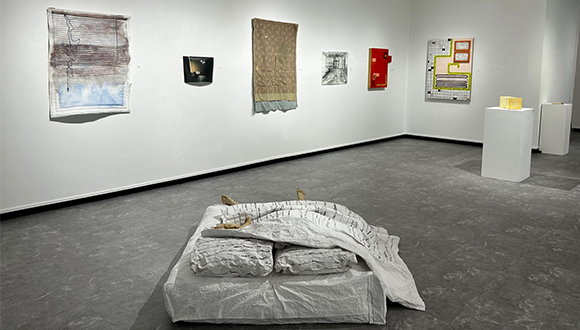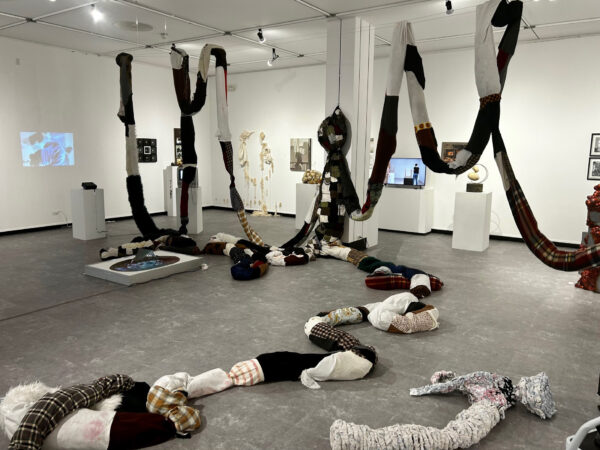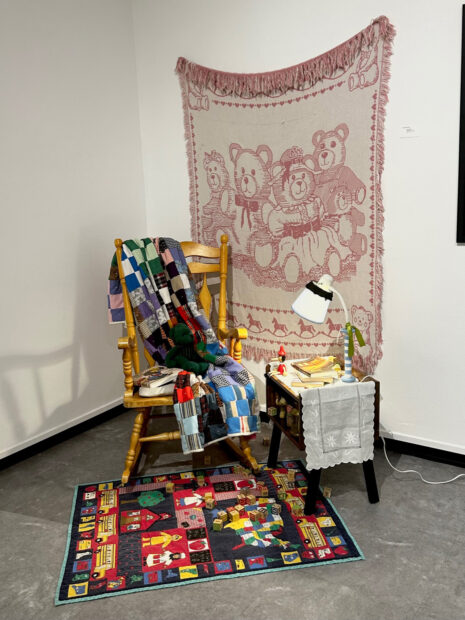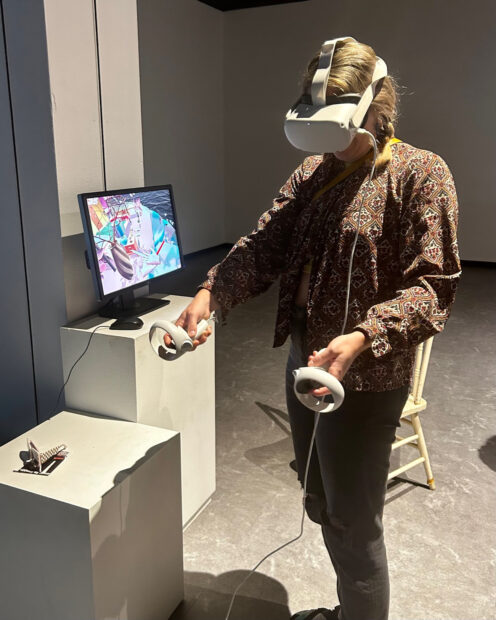Lost, Sought, Found, on view from June 2 – July 2, 2023
When stepping foot into Arts Fort Worth, one of the first galleries you’re greeted with is a group exhibition titled Lost, Sought, Found. Before I even began to explore the artwork, the tranquil energy of the room slowed my pace. There are times I forget how hasty I am when looking at art, until I come across works that remind me, ever so subtly, to slow down. Featuring a collection of works by five emerging artists based in the North Texas area, I was immediately met with familiar images: beds, bodies, architectural spaces, and a variety of common household items.
The first piece that caught my eye was the large mattress in the middle of the gallery, complete with sheets, pillows, two feet sticking out from under the covers, and a small brown teddy bear (which so warmly reminded me of the brown teddy bear that I sleep with every night). Multimedia artist Beronica Gonzales made this recreation of her bed, titled This is Me Taking a Nap (My Idea of Comfort), entirely out of paper (including paper pulp legs cast from her own legs), replacing the usual comfortable bedding material with a stiffer medium. Other works by Gonzales that stood out to me include a collection of used sticky notes threaded together in various compositions, and a muslin calendar embellished with sewn-on jet aircrafts, each piece a representation of the passage of time or a reflection of a time once passed.
Multimedia works on paper by artist and educator Matthew Ryan Johnson submerge gallery visitors in an otherworldly reality. His dreamy compositions seem to combine the real with the mythical. My favorite of his pieces, Molt (Immunity), fuses gouache, colored pencil, and graphite together to create a hazy fog of a landscape. The work borders on existential, questioning the transitory nature of the present moment or the recollection of perceived memories. Johnson’s phenomenological approach to depicting space and time holds an ethereal beauty and elasticity.
Two photographs by Grace Nicole added a distinct vulnerability to the show. Gazing into her photographs felt intimate and almost voyeuristic as I watch her inspect herself in the mirror or curl up comfortably in her bed. Nicole is a photographer whose work explores the Black identity, encompassing the complex lived realities and personal histories of her family and community. Visually and conceptually, Nicole imbues a softness into her work that asserts an unspoken warmth and empathy. Although the subject in her photos (in this case, the artist herself) engages in a private moment, the moment feels universal.
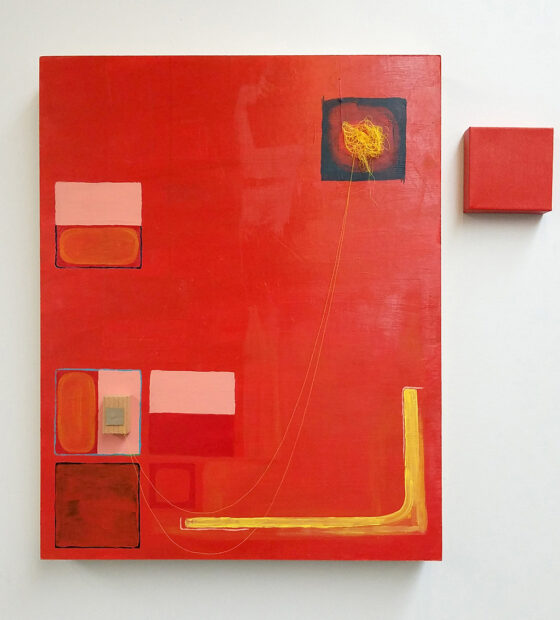
Elizabeth Hill, “Big Red,” 2018, acrylic, oil, faux leather patch, wooden blocks, thread on wood panel; acrylic on canvas. Photo courtesy of the artist
Artist Elizabeth Hill’s work departs from the rest of the pieces in the show in being largely abstract and geometric. Although the framework of the grid is used repetitively throughout the show, I see it most evidently in Hill’s multimedia works. The cleanness between forms and the delicate nature of each thin line or piece of thread reinforces the sequential and systematic undertones of her compositions. For her, the act of placing shapes within shapes is a way to visually represent and separate her thoughts. Big Red was the first of many pieces in which Hill began to explore creating boundaries or containers as a way of sorting through her mind and thoughts as a means of catharsis.
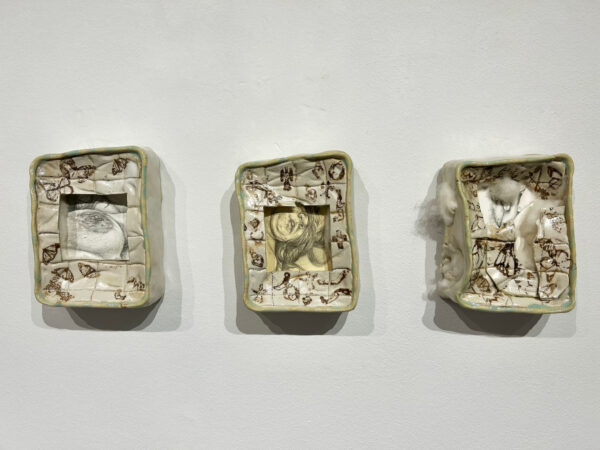
Magaly Cantú, “Mi Camita Quebrada no.1, no.2, no.3” (left to right), 2022, porcelain, screen printing, and graphite on paper
Magaly Cantú’s artwork employed a range of mediums within the exhibition, One series of three tiny ceramic shadow boxes in the shape of mattresses hung unassumingly at eye level. The porcelain frames were adorned with delicate images of butterflies and charms, while encasing small graphite drawings depicting the female body. Like many other artists within the show, Cantú uses the bed as a site to explore concepts of fragility and the complexity of inhabiting a body. The intimacy of her subject matter is reinforced by the layering and combining of materials, which produces works that are wholly personal and sincere.
This exhibition marks the curatorial debut of artist Kay Seedig. When talking with Seedig, they explained that some of the key ideas they discussed with the artists during the conception of the show were absence, presence, softness, windows, and the bed. “As we connected during studio visits, I realized a pattern was emerging: the work we decided on was both new and old. This juxtaposition begs the question, what is happening in the body and mind as they reflect on their experiences at that time and compare it to their present lived experience? These wonderings tend to be universal,” Seedig told me. “In my own work, and I think for many creatives, what we produce serves as a marker in time, and when we take time to look back, we are transported to a past place, feeling, or experience. Change has inevitably taken place, like the clarity of our memories or what was important at the time.” Indeed, the exhibition was an inward exploration of the many nuanced experiences of perceiving space and time, past and present.
*****
Be Home in 10, on view from May 5 – June 24, 2023
Directly opposite from Lost, Sought, Found is a larger group exhibition curated by Jillian Wendel and featuring works from The Anti-Avant Garde Avant Garde, a collective of more than 60 artists formed in 2021 within the College of Visual Art and Design at the University of North Texas. Much like its neighbor across the hall, Be Home in 10 is also a reflection on space and time, though more specifically on the way time affects our perception of ourselves and the spaces around us. The title is reminiscent of the all-too-common parental warning of “be home in 10 minutes,” a phrase that incites a momentary panic as you race to get home before the clock strikes.
The exhibition space was quite literally filled with work from floor to ceiling, prompting gallery visitors to weave their own paths through the artwork, ducking under hanging sculptures and stepping over TV chords. Each time I circled the gallery, I did so (unintentionally) in a different order, causing me to spot a work I didn’t notice before. The range of media and style, as well as the method of displaying the works together, made it impossible to know where to start looking and where to stop, but I suspect that was the precise intention.
Snaking through the gallery like a giant python is a soft sculpture made of recycled cloth and plastic by interdisciplinary artist Hannah Baskin. The work creates a jungle of patchwork blobs, enticing viewers to explore the fabric foliage. Hidden behind the monstrous garment is an artwork that almost blends in to the wall; it is titled Regurgitation #3, and is by Chloe Long. Indeed, the mess of fabric does feel like a regurgitation of the material which has been splattered upon the wall, but there is something very gentle and sensual about the piece. Perhaps it is the way the textiles are so carefully unraveled and then tangled back together. Each thread is inherently delicate, but in mass they form organic clumps which are rhythmically pinned to the wall and spill out onto the floor. The dynamic nature of the piece feels both chaotic and elegant.
One of my personal favorite corners of the gallery is filled with a found object installation by Sydney Stricker. This assemblage is composed of sentimental and childlike objects: a rocking chair, children’s books, wooden abc blocks, a quilt, stuffed animals and toys, a small nightstand with a lit lamp. Found and collected objects are a powerful way to remember the past; even if your childhood wasn’t furnished with a vintage Flagship schoolhouse rug and a perfect patchwork quilt, these items still evoke a reminiscence of “the good old days.” Regardless, this peaceful and calming little corner somehow reminded me of home.
Be Home in 10 was like unpacking a time capsule from art school (I didn’t graduate that long ago, but it still conjured nostalgia). The work is as experimental and exciting as it is authentically youthful.
*****
Between an Egg and a Wall, on view from June 2 – 24, 2023
In one of the corner galleries in the back of the building is a dark room lit primarily by screens, video projections, and LED lights. This exhibition is Between an Egg and a Wall, a title that derives from a 2009 acceptance speech given by Japanese writer Haruki Murakami: “If there is a hard, high wall and an egg that breaks against it, no matter how right the wall or how wrong the egg, I will stand on the side of the egg. Why? Because each of us is an egg, a unique soul enclosed in a fragile egg. Each of us is confronting a high wall. The high wall is the system which forces us to do the things we would not ordinarily see fit to do as individuals . .. We are all human beings, individuals, fragile eggs. We have no hope against the wall: it’s too high, too dark, too cold. To fight the wall, we must join our souls together for warmth, strength. We must not let the system control us – create who we are. It is we who created the system.” Being an avid reader of Murakami, I mulled this quote/metaphor over while exploring the exhibition. The room held only seven digital and video works by artists Maritza Bautista, Julie Libersat, Laila Saber Rodriguez, David Anthony Sant, and Jiatong Yao.
One of the first pieces I approached was an audio/video projection by Maritza Bautista, titled Casas de Cambio (Money Exchange Locations). On a table directly in front of the looped video was a pile of zines, which depicted money exchange locations in Laredo, Texas. Bits of text laid over the images within the zine read “Hay muchas casas de Cambio, sin cuenta. Pero debajo del agua nada. Mucho pez.” Having just returned from a trip to Mexico, I flashed back to the brief moment I entered a bank to exchange my dollars for pesos, a moment I didn’t give much thought to or reflect on — it was merely a task to complete. Bautista explores aspects of life which could be considered mundane, such as an overlooked interaction of exchange and the transference of value.
Like Bautista, the other artists in the show also explore the relationship between humans and our environment, our interactions within these spaces, and the overall significance of those narratives. In the middle of the room was a virtual reality simulation by tech artist Jiatong Yao, titled Little Island. Gallery visitors eagerly awaited their turn to put on the VR headset and hand controls to explore a small island that appears to be floating like a raft in the middle of the ocean.
Set up like a tropical bedroom complete with a bed, a nightstand, a lamp, lawn chairs under a large umbrella, a slide, and palm trees with coconuts that you can pick up and throw around with your virtual hands, there is something oddly unsettling about the plastic paradise. Maybe it’s the overwhelming sense of isolation, or that the only task to do is mindlessly throw coconuts into the water. I contemplated how humans interact with physical versus virtual spaces, especially considering the age of technology that we are all living in. But even if it’s a virtual world, it’s still a lived experience, right?


